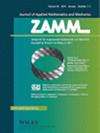基于血液的卡森混合纳米流体在对流加热的双向拉伸表面上的磁流体动力学被动控制
IF 3.2
4区 工程技术
Q1 MATHEMATICS, APPLIED
Zamm-zeitschrift Fur Angewandte Mathematik Und Mechanik
Pub Date : 2023-09-11
DOI:10.1002/zamm.202200576
引用次数: 1
摘要
混合纳米流体用于纳米技术,是一种先进的流体类别,具有丰富的热性能,比纳米流体产生更好的效果。混合纳米流体在工程化妆品、汽车工业、家庭工业、癌症治疗、纺织品、纸塑料、油漆和肥皂中有太多的应用。本研究的目的是研究卡森混合非牛顿纳米流体在扩大表面上的磁流体动力学传热速率。目前的工作重点是磁流体动力学混合纳米液体在扩展的三维薄片上的流动。此外,在本研究中,零质量通量和适当的对流加热过程被用作边界条件。血液作为基液,铜和氧化铝纳米颗粒溶解在其中,形成混合纳米流体。调整适用的相似变换,将模型方程转化为无量纲形式。同伦分析方法(HAM)计算得到的系统,并用图形说明它们,以解释在延伸的导电表面上的流动行为。此外,对于非量纲物理约束值的变化,解释了诸如表面摩擦、温度、努塞尔数和速度剖面等物理量的变化。目前的研究结果表明,磁场和非牛顿参数降低了杂化纳米液体的速度。温度分布随着热泳运动和布朗运动而上升。速度分量随着拉伸比参数的增大而减小,而方向上的速度分量则受到相反的影响。当化学反应的参数向上调整时,浓度曲线就会恶化。研究发现,混合纳米流体的热传递速率明显高于纳米流体的热传递速率。本文章由计算机程序翻译,如有差异,请以英文原文为准。
A passive control of magnetohydrodynamic flow of a blood‐based Casson hybrid nanofluid over a convectively heated bi‐directional stretching surface
Abstract Hybrid nanofluids, which are used in nanotechnology, are advanced fluid classes with enriched thermal properties that produce superior outcomes than nanofluids. There are too many applications of hybrid nanofluids in engineering cosmetics, the automotive industry, the home industry, cancer treatment, textiles, paper plastics, paints, and soaps. The purpose of this study is to investigate the heat transfer rate of magnetohydrodynamic flow of Casson hybrid non‐Newtonian nanofluid across an enlarging surface. The current work focuses on magnetohydrodynamic hybrid nanoliquid flow across an extending 3‐D sheet. Additionally, zero mass flux and an adequate convective heating procedure are used as boundary conditions in this investigation. Blood serves as the base fluid, into which copper and alumina nanoparticles are dissolved to form a hybrid nanofluid. Adjusting the applicable similarity transformation, the present modeled equations are converted into dimensionless form. The Homotopy analysis approach (HAM) computes the resulting systems and illustrates them graphically to explain the flow behavior at the extending electrically conducting surface. Additionally, for changes in the non‐dimensional physical constraint values, the variations in physical quantities such as the skin friction, temperature, Nusselt number and velocity profiles are explained. The results of the current investigation demonstrated that a magnetic field and a non‐Newtonian parameter reduce the hybrid nanoliquid's velocity. The temperature profile goes up with thermophoresis and Brownian motion. The component of velocity is found to fall as the stretching ratio parameter rises, while the component of velocity in the direction experiences the opposite impact. When the parameters of a chemical reaction are adjusted upwards, the concentration profile deteriorates. It is originated that the rate at which heat is transferred by hybrid nanofluids is significantly more progressive than that of nanofluids.
求助全文
通过发布文献求助,成功后即可免费获取论文全文。
去求助
来源期刊
CiteScore
3.30
自引率
8.70%
发文量
199
审稿时长
3.0 months
期刊介绍:
ZAMM is one of the oldest journals in the field of applied mathematics and mechanics and is read by scientists all over the world. The aim and scope of ZAMM is the publication of new results and review articles and information on applied mathematics (mainly numerical mathematics and various applications of analysis, in particular numerical aspects of differential and integral equations), on the entire field of theoretical and applied mechanics (solid mechanics, fluid mechanics, thermodynamics). ZAMM is also open to essential contributions on mathematics in industrial applications.

 求助内容:
求助内容: 应助结果提醒方式:
应助结果提醒方式:


